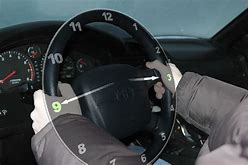“I see a lot of older drivers, driving their cars, hanging onto the steering wheel at 10 to 2 position (as were taught pre-airbag days) or, shock/horror! even 5 to 1.
“The issues of Takata airbags aside (and the repair rollout is taking an interminable time as it is), the danger to the driver’s wrists and arms is unstated but probably significant, let alone drivers who sit too close to the steering wheel.
“The force of an airbag in an accident, and just what that could do to arms, wrists and chest in an accident must be considerable. Thoughts?”
writes Mark from WA.
Great point, Mark. Older drivers were taught a completely different means of holding the steering wheel (and, indeed, the proper way to align themselves in the driver’s seat – remember the Stirling Moss arms-at-full-stretch, legs-at-full-stretch attitude that we all thought was de rigeur?)
Things have changed, and sadly, many older drivers haven’t adapted.

As you rightly point out, when an airbag detonates, it does so with explosive force. If your arms or wrists are in the way, they will be forced backwards with great force. Potentially, if there’s a wristwatch on your arm, this could inflict a fatal blow to your face, or at the very least, a broken nose or concussion. Sitting too close to the steering wheel is also a dangerous practice, placing your face and upper body directly in line with the detonating airbag when it is at its most potent. The US National Transportation Safety Board has reported some truly horrific injuries as a result of drivers incorrectly placing their hands on the steering wheel. These include severed fingers or hands, broken arms and even cases where the skin is torn away completely from the fingers and hand.

Not only is holding the wheel at the 12 o’clock position potentially dangerous if the airbags go off, it also means you have minimal control over the vehicle. Once upon a time, it was recommended that we hold the wheel with the hands at the 10 to 2 position (think of the steering wheel as a clock face where 12 is at the top, 9 and 3 at the extremities and 6 at the bottom). Nowadays, best practice is to place your hands at 9 and 3. Most modern steering wheels even have indents to subtly prompt you to do so. Despite this, many drivers persist in holding the wheel in other positions, including, as you observe, the asymmetrical 5 and 1, the lazy 5 and 7 or the position I refer to as the Foo position, both hands at 12 o’clock.

Nothing annoys me more than to see an oncoming vehicle where both the driver’s hands are visible – that means the driver is holding the steering wheel incorrectly and has less than ideal control of the vehicle.
Placing your hands at the 9 and 3 position on the steering wheel aligns them with your shoulders, a natural and comfortable alignment. It also means your hands are in the proper position to use the recommended “push and pull” method of turning the steering wheel. (Peter Brock was an advocate of keeping the hands in one place on the wheel, even if it meant crossing the arms when turning. However, with airbags, this means that the crossed arms are a real risk should the airbag go off.)

The push-pull turning method means your hands never need to leave the steering wheel; if you are turning right, you push the wheel in a clockwise direction with your left hand while simultaneously pulling it in a clockwise direction with your right hand. Never turn the wheel using only the palm of your hand or with your thumbs. Another good piece of advice is to keep your thumbs outside the rim of the steering wheel rather than hooked around it – if there is a collision and the steering wheel is suddenly turned by the impact, your thumbs can suffer significant injury if they are inside the spokes. It goes without saying that holding and operating the steering wheel using the spokes alone is very poor driving practice, as is operating the steering wheel using your knees. And another no-no is the underhand grip to make a turn – if the airbag deploys (and remember, it does so at more than 300km/h) at the very least, you’ll suffer a broken wrist.
So thanks, Mark. Holding the steering wheel is such a basic driving skill, and yet many drivers are getting it wrong. And the consequences are potentially catastrophic.
